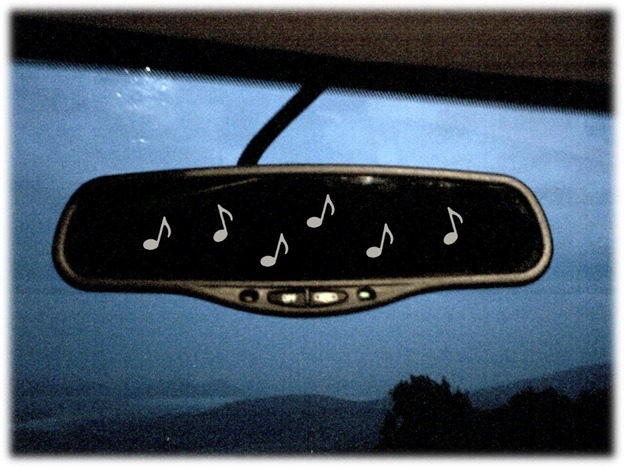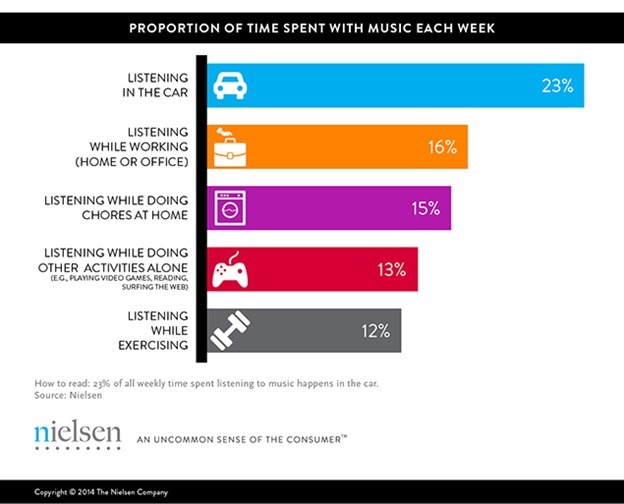 In yesterday’s post, we discussed how the evolution of digital media and technology may be altering the role that broadcast radio plays in the music discovery hierarchy.
In yesterday’s post, we discussed how the evolution of digital media and technology may be altering the role that broadcast radio plays in the music discovery hierarchy.
The spate of new options for consumers points to a familiar theme for this blog: the media environment has been repopulated with many new digital channels that play a growing role in shaping consumer tastes and broadcast radio’s competitive landscape.
Yet, radio continues to operate like it’s still in the ‘80s, as Station A continues to battle with Station B for ratings in the zero sum game known as audience share. As the Nielsen weeklies roll out, closely covered by the industry trades, they foster the illusion that broadcast radio operates in a competitive vacuum, competing for cume, AQH, and dollars in what has traditionally been an insular audio media world. Not anymore.
Back in those “good old days,” most people discovered new music and breakout artists the same way – on the radio, from friends, or a combination of the two. People’s tastes have always been diverse, of course, but the discovery paths were very similar and linear.
But as yesterday’s study of the impact of Spotify and Shazam on new music clearly shows, other dynamics are very much in play that are impacting radio’s relationship with audiences and how interface with media to enhance music discovery.
In many ways, radio has been here before. As a programmer of a rock station in 1981 when MTV debuted, it was clear to many of us in just a few short months that music videos were the new currency, changing the discovery/consumption equation.
 MTV rapidly became a go-to destination for artists and labels, providing a high-profile launching pad for new music. For FM music stations, MTV’s influence and power became a challenge. It forced stations to rethink how a song debuted, how it was perceived, and how the options available to local radio brands for exposure, concert support, and special programming had changed.
MTV rapidly became a go-to destination for artists and labels, providing a high-profile launching pad for new music. For FM music stations, MTV’s influence and power became a challenge. It forced stations to rethink how a song debuted, how it was perceived, and how the options available to local radio brands for exposure, concert support, and special programming had changed.
In some ways, MTV was the Pandora of the ’80s. But back in those days, MTV was really the only real change agent.
But today’s multi=media digital superstore is more analogous to the simplicity of World War II where America could clearly focus on three common enemies known as the Axis versus the complexity of the War on Terrorism or cyber-attacks, where it isn’t always easy to pinpoint the precise source of the disruption. trouble.
To a great degree, it’s the difference between what radio faced in the ‘50s with television versus the explosion of a seemingly infinite number of options today.
In many ways, “connected cars” symbolize the challenges facing broadcast radio today. Paul just leased a new Toyota RAV4 – not a luxury vehicle by any means. But in that dashboard is easy access to every local HD radio channel, embedded apps for iHeartRadio, Pandora, and Facebook, as well as weather, maps, satellite radio, and Bluetooth access to a smartphone and all the content it contains.
As we saw at CES last week, both Apple’s Car Play and Google’s Android Auto will be in many dashboards soon, along with embedded apps and other sources that provide consumers with more and more options.
We often talk about the new rules of music discovery, but for radio to be “discovered” and regularly used in these new vehicles, it will demand a rethinking process that focuses on the jobs that consumers hire FM stations to do in 2015 in these “connected cars.”
The good news is that music matters a lot to consumers – in some ways more than at any time in the past. According to Nielsen’s Music 360 study from this past October, it’s their top form of entertainment. Overall, three-fourths of Americans make the music choice, with TV coming in a close second.
A key reason is that music integrates with people in a variety of their listening locations and lifestyle environments. On a weekly basis, the car, at work, and the home front (doing chores) are the three prime music locales on a weekly basis. This is all familiar to radio people who have historically programmed their stations to be compatible with these same listening environments.
But the distribution outlets and their corresponding choices in these spaces are expanding, forcing radio to strategically rethink what it can deliver in each of these environments that is different and more desirable than the other available options.
This now means more than simply playing the high-performing hits, time-stamping listening appointments, and giving away $1,000 a day. It means radio needs to stop staring at the rearview mirror and the way things have always been, and instead, start looking out the windshield to redefine itself in this new, uncharted journey of audio entertainment and information. Radio needs to redefine its role in the audio ecosystem.
It’s time to get out from behind the curve.
- What To Do If Your Radio Station Goes Through A Midlife Crisis - April 25, 2025
- A 2020 Lesson?It Could All Be Gone In A Flash - April 24, 2025
- How AI Can Give Radio Personalities More…PERSONALITY - April 23, 2025





Thanks Fred for the insightful article.
It would be helpful if broadcasters remember what Apple did. They went on offense while broadcasters appear to be on defense.
Seeing MP3 sales in the iTunes store fall as Pandora’s app rose, Apple had 2 options: A: lose share or B: compete online with Pandora. Apple chose the latter. Broadcast radio chose the former.
You can argue iHeart is broadcast radio competing online, except, it’s not even close…The Triton numbers prove that iHeart’s audience has been flat for more than a year, flat, small and only a percentage of Pandora’s audience, lagging behind iTunes Radio, Spotify and even SoundCloud. Their failed strategy is a warning sign to other broadcasters. Get into the streaming game with something meaningful to listeners and do what Apple did, cannibalize your FM business. Sound crazy? If you don’t compete with yourself, remember, your FM monopoly is dead – anyone can compete with you online, diminishing your FM audience.
Paul, clearly the new landscape requires new thinking and new strategies. Broadcast radio has some powerful assets, but its core purpose is being impacted by digital technology. Thanks for taking the time to comment.
I just started streaming this week — I found there’s only one alternative to getting listeners to listen to your standard radio without streaming — that’s when you have a slow connection to streaming. Having a station that cuts in and out is frustrating however, as you know — that too will change. It’s the horse and buggy vs. the automobile — The more the audience is “streamed up” the less they will remember the “good ole days”. I have found myself as dedicated to programming this new station as if I was sitting in some FM station getting paid for it. It’s a labor of love.
Content is content, whether it’s floating through the air, via satellite, or via a digital stream. Distribution is about delivering it whenever and wherever consumers want it. But the heart and soul of it doesn’t change for any delivery format. Thanks, Stoney.
I think it will be extremely hard for artists to break without radio regardless of the dash. All of these streaming services are great but they play random music or music you personally choose. Radio is the ultimate hype machine. Also without radio these artists aren’t selling tickets and that’s the only way they make money anymore. Something is going to give at some point.
Eric, the post echoed these thoughts – radio has some amazing assets that any artist or project needs to have in order to succeed. Radio may often be late to the party, but its impact is still very apparent.
Thanks guys, very insightful, smack on point, valuable!…that was great Fred!
It took a while Fred, but I finally took my entire air staff and promo team for a digital dash training day this past week at a local dealership. it was remarkable for them and a eye opener for me as well. You should see their face drop when they saw, on a very average new car…the gas prices at the closest gas station pop up on the display.
Highly recommend this experience for all broadcasters.
Great exercise, Dave, and I’m thrilled that your “DASH education” is paying off. That’s a great “real world” exercise, it probably wasn’t THAT hard to set up, and the dividends were evident. Thanks for sharing – it’s a great idea.